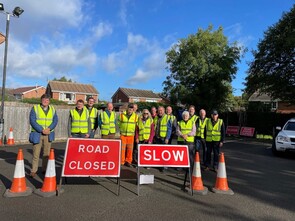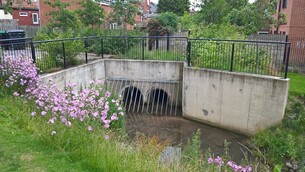 As your local county council, we are the Lead Local Flood Authority responsible for managing local flood risk in Nottinghamshire.
We work alongside partners to manage flooding from local sources, such as surface water and watercourses, and we are responsible for developing and applying a strategy for local food risk management across the county. To manage the risk of flooding from other sources we work with partners such as the Environment Agency, VIA East Midlands and Severn Trent.
Educating future generations

We believe that education and sharing of experiences is vital to managing flood risk, now and in the future, and that children play a key part in this. Over the last 18 months we have delivered interactive flood risk sessions to nearly 1000 primary school children across 13 schools.
These sessions challenge children to make their own decisions about ways to reduce the risk of flooding and ties into their curriculum by using a variety of interactive tools such as our Augmented Reality Sandbox. This is an incredible bit of modern technology that allows children to model flood risk management solutions in real time and to see the effects that their chosen landscape has on water flow.
We also help children to build their own flood walls to (hopefully) protect their teachers’ feet from getting wet! Our sessions are so popular that we are already booking up for the next school year.
|
Community Flood Signage Scheme

The Community Flood Signage Scheme (CFSS) allows trained members of the community to close roads during times of flooding, which promotes road safety and stops vehicles creating bow waves which can cause further damage to property.
120 Signage Wardens have been trained and seven new Flood Signage Schemes have been developed over the last year, with another in development, bringing the total number to 18. These cover:
Bleasby, Burton Joyce, Caythorpe, Collingham, Colston Bassett, Cropwell Butler (in development), Girton, Holme Pierrepoint, Lambley, Lowdham, North and South Wheatley , Shireoaks, South Muskham and Little Carlton, Southwell, Sutton Bonington, Thurgaton, Woodborough and Worksop.
New online training modules, as well as new information resources, have been made available and we will continue to expand this initiative across the county. We have also contributed to the purchase of a brand new Resilience Store in Worksop which can be used for equipment storage as well as the storage of emergency items such as sandbags.
|
Flood risk register of assets

The county council maintains a register, jointly developed with Nottingham City Council, of 2000 assets that have a significant effect on flood risk across the city and county. The register includes bridges, culverts, historic structures, retaining walls and other drainage structures which are routinely inspected. The register can viewed online via the link below.
|
Sustainable approaches to planning applications

Do you know that the council encourages and promotes the use of Sustainable Drainage Systems (SuDS) in all new developments?
We provide technical advice and comments on surface water drainage to local planning authorities on all major and sensitive developments. Between 1 April 2022 and 31 March 2023, we received consultation requests for 985 planning applications.
Our comments have helped protect tens of thousands of new properties and support sustainable growth across the County.
|
Preliminary Flood Risk Assessment

The council is required by law to produce a Preliminary Flood Risk Assessment (PFRA) that covers the risk of flooding from local sources, namely ordinary watercourses, surface water and groundwater. Reducing flood risk from main river watercourses is the responsibility of the Environment Agency.
We have undertaken a comprehensive review and rewrite of the original PFRA to bring it up to date and in line with current policies and strategies. This includes the analysis of potential future flood impacts using the latest surface water flood risk data as well as a review and verifying exercise of historic flood data.
|
Do you have water next to your property?

Our county contains many miles of ordinary watercourses - ditches and dykes that are used to carry surface water across land. Did you know that in most cases the responsibility for maintaining these watercourses lies with the adjacent landowner? This responsibility is called Riparian Ownership. We work with many landowners offering advice on how to keep their watercourse clear and have a useful leaflet explaining riparian responsibilities in more detail that can be downloaded below.
A watercourse or feature cannot be altered, removed or replaced without Land Drainage Consent.
|
|